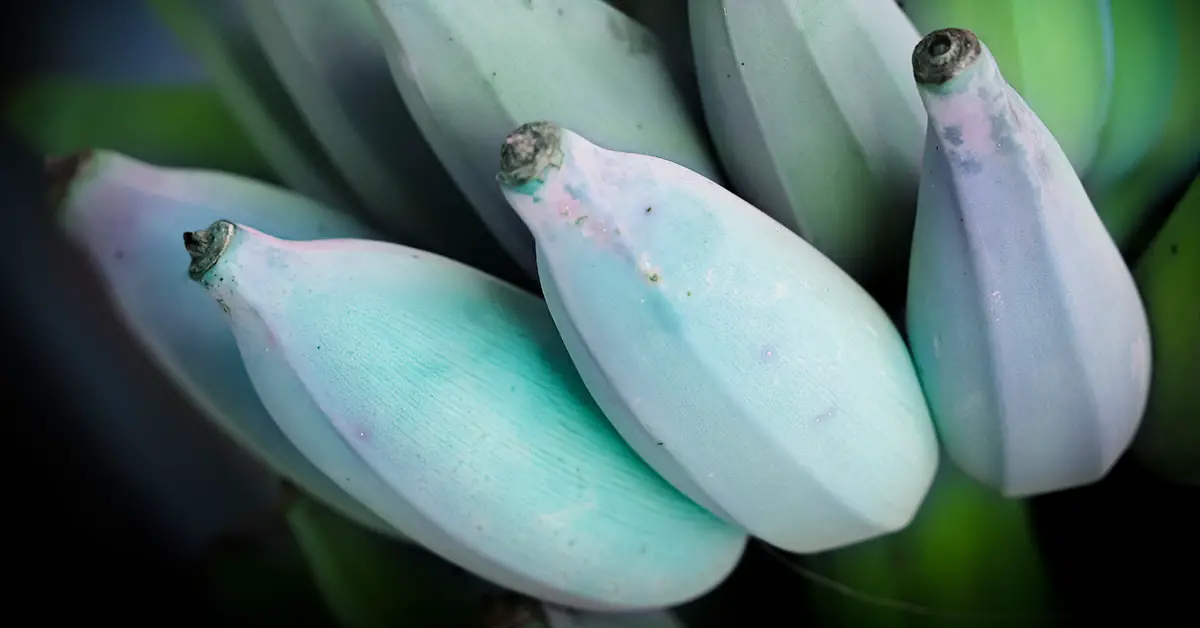This banana variety is one of the most incredible things in the world… in my humble opinion. The Blue Java banana is a banana variety popular for its striking similarity to vanilla ice cream in both taste and consistency. It has a sweet, appealing aroma, and it’s called Blue Java because its peel has an aqua blue color when it’s unripe. They have this frosted tinge all over the peel that makes it look as though they are permanently frozen. The ripe form has a greenish or pale yellow color, with the insides whitish-yellow. It’s identified by several names; ice cream banana in Hawaii, Cenizo in Central America, and Hawaiian banana in Fiji.
The cultivar originated from South East Asia, spreading through continents to Northern Australia. Bananas are generally tropical fruits. This means they don’t do well in cold regions. Most banana varieties will not grow past an average 40 F of temperature. They usually begin to die off at 28F. The Blue Java banana, however, is a hardy variety that will keep growing in temperatures as low as 20F / -7c.
Want To Grow ‘Vanilla Ice Cream’ On Your Property?
If your climate and property are suitable for a banana tree here is what you need to know. In the United States, The Blue Java banana is suitable for growing in the USDA’s zones 9b through 11, although some farmers grow from zones 8 through 11, which are part of the hardiness zones. This zone map divides North America into 11 zones, each zone 10 F warmer or colder than the adjacent left or right zone. They enable farmers and gardeners to know where best a plant is most likely to thrive nicely.
A fully mature Blue Java tree will get to somewhere around 15 to 20 feet in height. If you plant a pseudostem, it takes about 9 months from the time the leaves first appear for fruits to mature. On the other hand, you can have trees at various stages of development delivered directly to your house.
Bananas don’t usually require a lot of energy, but you do need to have a few solid gardening tips to get the Blue Java on track [2].
- Watering is extremely important, but also tricky to handle. Bananas love mushy conditions. They like warm, rich soil with high moisture. During the growing season, water the tree frequently and adequately, but not to the extent of floating. Also, know the depth of the soil, so water doesn’t pull down below and give rise to root rot.
- Bananas require a lot of fertilizing. Use an NPK fertilizer with nutrients in the ratio of 3:1:6 to nurture your plant. For a one foot tall plant, nurture with 1 cup of fertilizer per month. Be sure to fertilize when the weather is expected to be reasonably warm. Spray the fertilizer all around the roots and water the particles down into the soil. For every additional two feet the plant grows, add one more cup of fertilizer to the mix.
- Prune the secondary shoots around each rhizome. Leave at least one shoot around the plant to enhance photosynthesis. Excess shoots will compete for nutrients which may cause the tree to be stunted.
- Bananas require sunlight to germinate. It can be partial to full sunlight, but constant overcast is bad for germinating plants.
Read: Student made a gown out of 1,400 mango seeds to highlight food waste
Where to Get Blue Java Banana Trees and Seeds
There are multiple places you can purchase this delicious variety. Amazon offers both trees and seeds for purchase, but you can find it from other online retailers as well like FastGrowingTrees.com and Etsy.
Blue Java Uses
The Blue Java Banana has wide, strong, and thick leaves like any other banana variety. These leaves can be used in place of aluminum foil, parchment paper, or other wrappings for cooking. They can be used for baking, boiling, steaming, grilling, and drying. It should be noted that banana leaves are porous, unlike foil or parchment paper, so juices from the food may leak through. If you’re using an oven and would like to prevent this, you place the leave wrapped food in a casserole dish to catch the juices.
Since the Blue Java banana tastes just like vanilla ice cream, you can eat it in place of the ice cream. Bananas are energy-dense foods and are low in fat. 100 grams of banana contains about 0.3g of fat, 22.8g of carbs, and 89 calories.
Bananas are among the richest natural sources of potassium. Potassium is a mineral nutrient that supports proper muscle contraction and nerve cell response. Adequate potassium is important for proper heart contraction and helps to regulate blood pressure.
The Blue Java banana can replace ordinary bananas in every recipe. The subtle, almost vanilla flavor is to die for. They are amazing for banana cakes, smoothies, banana oatmeal cookies, banana pancakes, and they are mind-blowingly incredible in banana ice cream.
Click here to see some amazing banana recipes I’m sure you’ll love to try.
Keep Reading: People Online Say Watermelon Tastes Better With Salt On It
Sources
- “Blue Java Banana, The Smooth Banana That Tastes Like Vanilla Ice Cream.” Fine Dining Lovers. Diana Lee. March 20, 2019.
- “How to Care for an Ice Cream Banana Tree.” Home Guides. Teo Spengler. October 2, 2019.
- “How to Cook With Banana Leaves.” The Spruce Eats. Darlene Schmidt. September 17, 2020.
- “Bananas 101: Nutrition Facts and Health Benefits.” Healthline. Atli Arnarson BSc, PhD. May 7, 2019.
- “Potassium Rich Foods.” WebMD.
- “Banana Recipes.” Chocolate Covered Katie.
- “Ice Cream Banana Tree.” Fast Growing Trees
- Plantardiness

